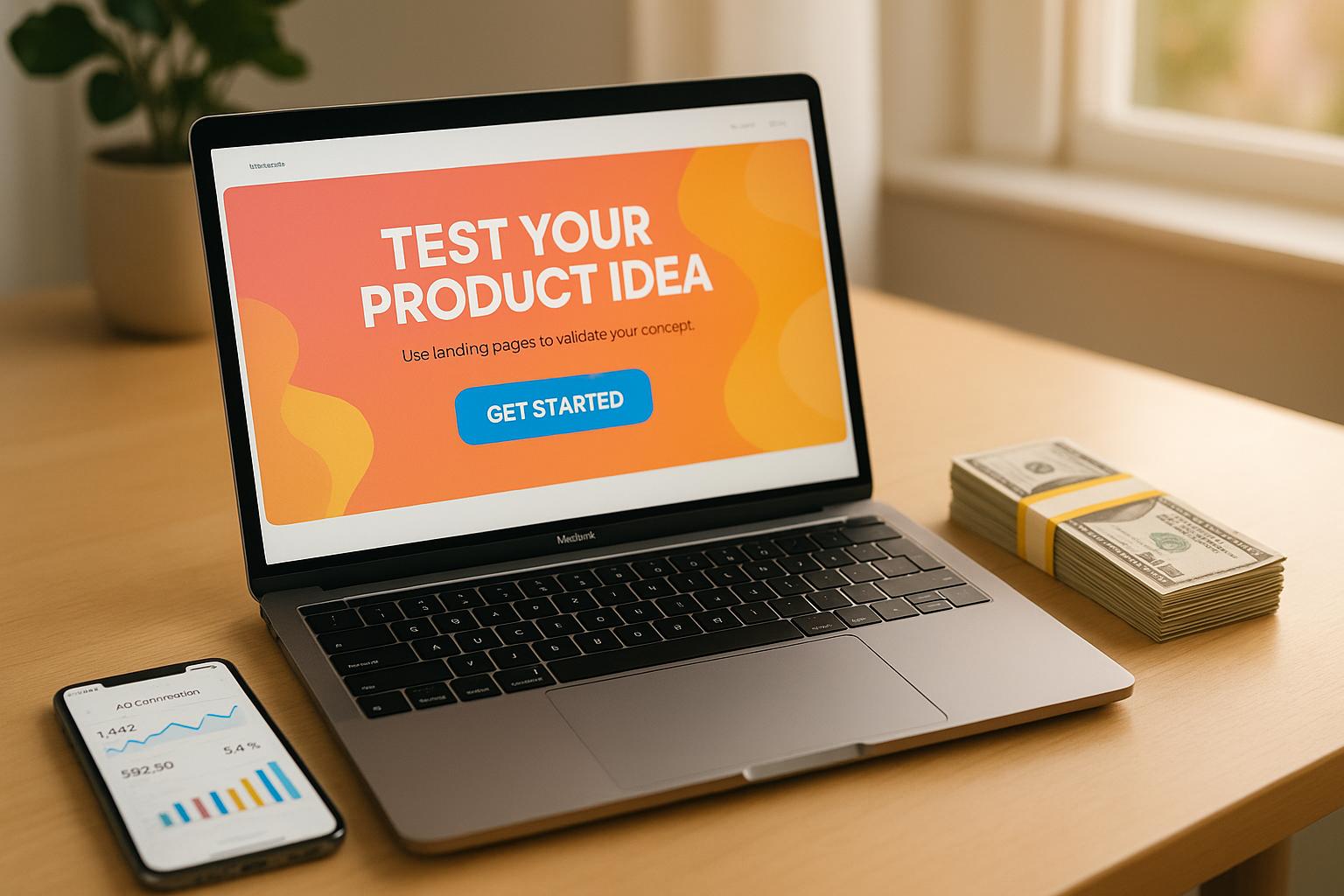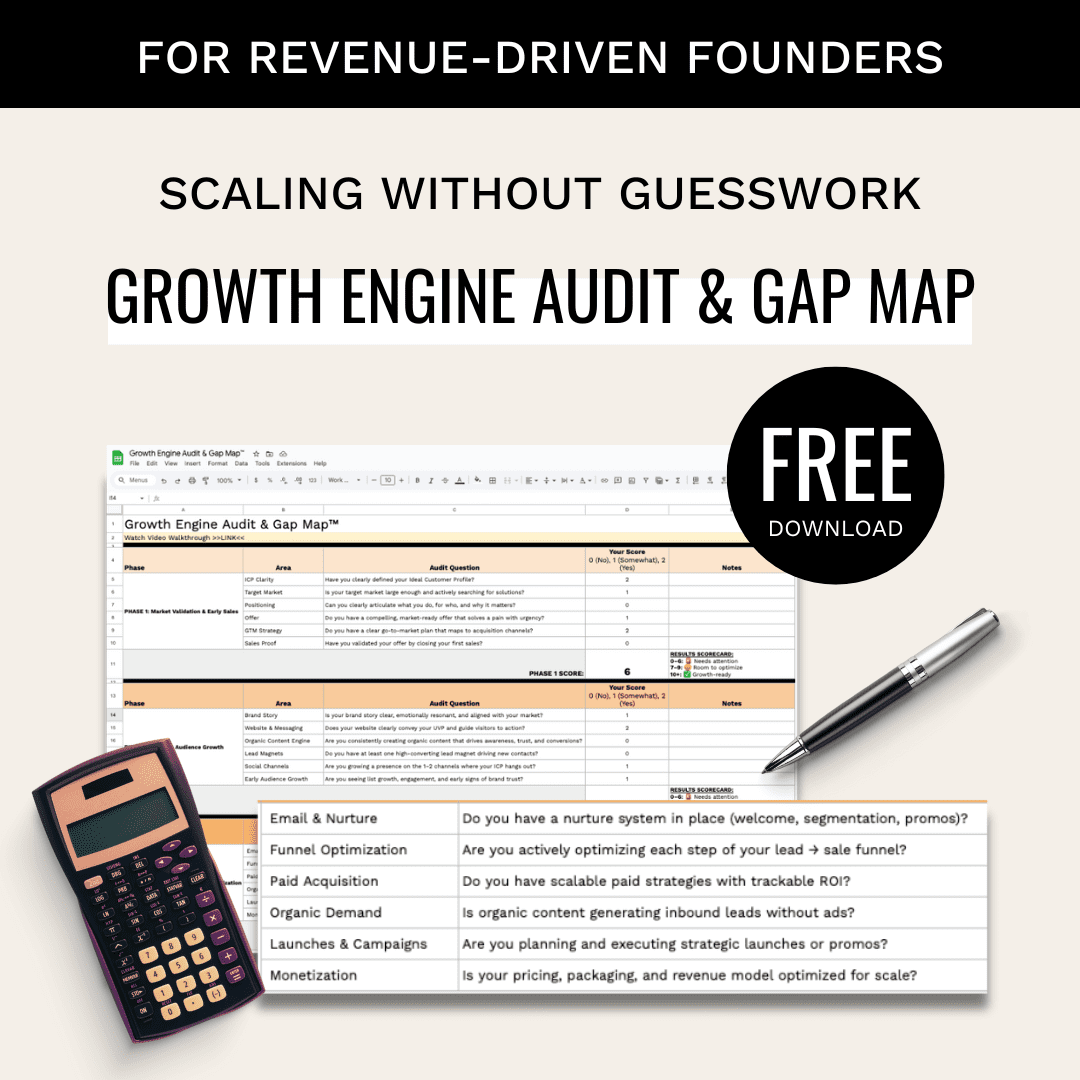Be sure to always test a new product idea before fully developing it can save time and money. Here’s how you can validate your idea using a simple landing page and a $100 ad budget:
- Create a Landing Page: Build a one-page site showcasing your product’s main benefit, clear visuals, proof points, and a strong call-to-action (CTA). Tools like Carrd can help you get started quickly.
- Run a $100 Ad Campaign: Use platforms like Google Ads or LinkedIn Ads to drive traffic to your page. Test different ad copies and allocate your budget effectively.
- Measure Results: Track metrics like click-through rates (CTR), sign-up rates, and engagement. Aim for at least a 6% conversion rate to validate demand.
- Gather Feedback: Conduct interviews with leads to understand their challenges and refine your idea based on their input.
Quick Comparison of Ad Platforms:
| Platform | Average CPC | Best For |
|---|---|---|
| Google Ads (Search) | $2.69 | People actively searching |
| LinkedIn Ads | $5.26 | B2B or professional audiences |
| Google Ads (Display) | $0.63 | Building brand awareness |
Greg Vasil: How to Validate Your Idea with Only Facebook …
Building Your Test Landing Page
Your landing page serves as the first interaction between you and potential customers. To make it effective, focus on delivering a clear message and structuring the layout strategically.
Writing Your Product’s Main Benefit
Your headline and main benefit statement are crucial for grabbing attention. These should directly address your customer’s biggest challenge or need.
"The most effective messaging uses language you’ve heard in 1:1 interviews and reviews." – Scott McLeod
Use this simple formula to craft your headline:
- Offer: What you’re providing
- Big Promise: The main benefit your product delivers
- Sparkle: A unique or intriguing element
For example, ePIPE saw a 190% increase in conversions by tailoring their headline to address customer concerns during the pandemic. Similarly, Shulman Law boosted their conversion rate by 95% by including location-specific terms like "Toronto" in their headline.
Creating a Basic Page Layout
Make sure your landing page includes these key elements:
- Clear Value Proposition: Place this prominently at the top of the page.
- Visuals: Use high-quality images that clearly represent your product or service.
- Proof Points: Highlight the main benefits and features of your offering.
- Strong Call-to-Action (CTA): Include one clear, actionable button to track conversions.
Your first CTA should aim for a 25% conversion rate, and the button text should be direct and to the point.
Once your layout is ready, the next step is selecting the right tools and strategies for your ads.
Landing Page Building Tools
Carrd is a great option for quickly creating a simple landing page. It offers both free and paid plans with the following features:
| Feature | Free Plan | Paid Plan |
|---|---|---|
| Number of Sites | Up to 3 | Unlimited |
| Custom Domain | No | Yes |
| Forms & Widgets | Basic | Advanced |
| Analytics | No | Yes |
| Branding | Carrd logo | No branding |
Before building your page, refine your copy in a Google Doc for clarity.
"Fall in love with the problem, not the solution." – Scott McLeod, Entrepreneur, artist, and growth marketer at Resident Home
To encourage conversions, consider offering perks like early access or exclusive discounts.
Once your landing page is ready, you can move on to testing it with a $100 ad campaign.
Setting Up Your $100 Ad Test
With your landing page ready, it’s time to launch a focused $100 ad campaign to gather actionable insights. By pairing your optimized landing page with the right ad strategies, you can create a campaign that effectively connects with potential customers.
Picking Your Ad Platform
The platform you choose plays a big role in the type of data you’ll collect. Each has its strengths:
| Platform | Average CPC | Best For |
|---|---|---|
| Google Ads (Search) | $2.69 | Reaching people actively searching |
| LinkedIn Ads | $5.26 | Targeting B2B or professionals |
| Google Ads (Display) | $0.63 | Building brand awareness |
For most product tests, Google Ads search campaigns strike a good balance between cost and intent. If your goal is to generate interest in a newer market, LinkedIn Ads might be more effective, as they focus on professional audiences who may not yet realize they need your product.
"Think of [Google Ads] as ‘what’ targeting – focused on specific keywords and content." – Emily Wood, Founder, Emily Wood Marketing LLC
"Think of [LinkedIn Ads] as ‘who’ targeting – centered on audience-specific criteria." – Emily Wood, Founder, Emily Wood Marketing LLC
Once you’ve chosen your platform, the next step is to create ads that clearly highlight your product’s benefits.
Writing and Testing Ad Copy
Your ad copy should be clear and engaging, addressing your audience’s needs directly. For example, AskNicely boosted their conversion rates by 67% and click-through rates by 219% simply by rephrasing their problem as a question in their ad headline.
Here are key elements to test:
- Headlines: Write 3–4 variations that focus on the problem and solution.
- Call-to-Action (CTA): Make it clear what action you want people to take.
- Value Propositions: Use specific details or numbers to stand out.
- Urgency: Add time-sensitive language to create a sense of urgency.
"The objective of a headline is not to sell, but to reach out and connect with the reader, and pull him or her into reading more." – MarketingExperiments.com
Once your ad copy is polished, it’s time to allocate your budget effectively.
Managing Your Ad Budget
Here’s a suggested breakdown for your $100 ad budget:
- Initial Split Testing: Use $20 over 2–3 days to test different ad variations and identify what works best.
- Main Campaign: Spend $70 on the top-performing ads and keywords.
- Adjustment Reserve: Keep $10 for fine-tuning bids on high-performing elements.
"Effective PPC budget management remains a critical challenge for marketers aiming to maximize returns on their advertising investments. Balancing between overspending and underinvesting requires a nuanced understanding of campaign dynamics, market fluctuations, audience behavior, and PPC competition." – Nikita Bykadarov, CEO at Maildoso
Set daily spending limits of $10–15 to ensure you gather enough data without burning through your budget too quickly. Keep a close eye on click-through rates (CTR) and conversion costs, and adjust your targeting and messaging as needed.
sbb-itb-e8c8399
Measuring Test Results
Once your landing page and ad campaign are live, it’s time to track key metrics. These numbers will help you gauge whether your product resonates with your target market. Focus on metrics like click-through rates (CTR), sign-up rates, and engagement to assess interest and demand.
Ad Click Rates
CTR shows how appealing your product’s value proposition is to your audience. A higher CTR typically means your messaging is striking a chord. For high-traffic pages, check your CTR daily. For pages with less traffic, reviewing it weekly is enough.
"Once your landing page is live, review your metrics after a specific amount of traffic has been received or after a set time period, such as a week. For high-traffic pages, I recommend daily reviews to stay on top of performance. For low-traffic pages, a weekly review will be adequate to monitor and make necessary adjustments."
– Waseem Bashir, Founder & CEO Apexure
Sign-up Rates
Clicks are great, but conversions matter more. Keep an eye on sign-up rates to see if visitors are taking action. Calculate your landing page conversion rate by dividing the number of email sign-ups by total page views, then multiplying by 100. Here’s how performance typically breaks down:
- Average: 2.35%
- Good: 5.31%
- Excellent: 11.45% or higher
"Conversion rate is the most crucial metric. It measures how well your landing page converts visitors into leads or customers."
– Axel Lavergne, Founder Reviewflowz
To test a new product idea, aim for at least a 6% conversion rate. If your rate exceeds 10%, it could signal strong market demand.
Page Engagement Metrics
Use tools like Google Analytics to track engagement metrics such as:
- Average time on page: Indicates how long visitors stay.
- Bounce rate: Shows the percentage of visitors who leave without interacting further.
- Scroll depth: Reveals how much of your content visitors actually view.
For example, Gogoprint used Hotjar Heatmaps to identify and fix problem areas on their page. This led to a 7% drop in their bounce rate and a 2% increase in conversions.
"We used Hotjar’s insights to narrow down the possible causes of drop-off. It enabled us to focus on and test a few real solutions instead of chasing hypothetical solutions based on guesswork."
– Piriya Kantong, Senior Online Marketing Analyst, Gogoprint
Review engagement metrics regularly, based on your traffic volume. When paired with conversion data, these numbers can give you a clear picture of your market’s interest.
Getting Customer Input
Once you’ve gathered data from your landing page, the next step is to collect feedback directly from potential customers. This feedback helps you go beyond the numbers, offering a clearer picture of what your audience truly needs.
Customer Problem Interviews
When interviewing potential customers, focus on uncovering their challenges before introducing your product or service. This approach ensures you get honest and unbiased insights.
"The biggest mistake I see otherwise well-intentioned founders and PMs make is that they come to their customer interviews with no preparation." – Jason Evanish
Here are some tips for running effective interviews with leads from your landing page:
- Start with context: Learn about their role and daily tasks. This helps build trust and gives you a better understanding of their situation. Use open-ended questions to explore their workflows and pain points.
- Dive into their challenges: Let them explain their problems in detail. Avoid jumping in or leading the conversation – just listen.
- Introduce your solution after understanding their needs: Once you’ve identified their challenges, you can share your solution. This ensures their feedback isn’t influenced by your pitch.
The insights you gather here will help you measure how well your test is attracting truly interested prospects.
Checking Lead Quality
After collecting feedback, it’s time to evaluate whether your leads align with your ideal customer profile. Look at their demographics, engagement levels, and survey responses to gauge their fit.
Lead Quality Indicators:
| Indicator | What to Check | Why It Matters |
|---|---|---|
| Demographics | Age, location, job role | Confirms they match your target market |
| Behavior | Time spent on page, scroll depth | Reflects their level of interest |
| Engagement | Survey responses, interview participation | Shows how urgent their problem is |
"No idea survives first interaction with a customer." – Steve Blank
To attract better leads, use the language and phrases you hear in customer interviews and reviews to refine your landing page copy.
Track how well your leads align with your ideal customer profile by monitoring:
- Engagement metrics: How they interact with your landing page
- Survey responses: What they reveal about their pain points and solutions they currently use
- Interview takeaways: How deeply they understand and feel their problem
Conclusion: Making the Build Decision
To test a new product idea and decide whether to move forward with your idea hinges on analyzing both numbers and feedback. By combining measurable data with customer insights, you can make a well-informed choice. Use the table below to guide your decision-making process:
| Success Indicators | Warning Signs | Action Steps |
|---|---|---|
| 25%+ conversion rate | Below 4.6% conversion | Refine your value proposition |
| 100–200 quality signups | Low engagement rates | Adjust your targeting |
| Positive customer interviews | High bounce rates | Improve your messaging |
"To validate your idea you need really need both acquisition and activation data."
- Scott McLeod, Growth Consultant
Here are the benchmarks your test results should meet:
- Conversion Performance: A conversion rate of at least 25% on your main call-to-action is a strong sign of market interest. Hitting or exceeding the 4.6% industry average is a good starting point.
- Quality of Interest: Look beyond the number of signups and assess engagement. For example, one case study highlighted a 16.89% conversion rate paired with a $0.94 cost per click, demonstrating precise targeting.
- Customer Validation: Ensure you’re attracting leads with real buying intent. As Dustin Mathews puts it:
"Just because people are handing you their email doesn’t mean they’ll buy when you launch. This is why you must optimize for learnings and not email signups."
If your metrics remain weak after refining your approach, it’s a clear sign of low demand. As Foti Panagiotakopoulos explains:
"Data doesn’t lie. If your conversion rate is low (or nonexistent) then you need to reconsider your positioning, product messaging, or some aspect of your business."
When you go to test a new product idea, the ultimate goal is to validate market demand, not just collect email addresses. Let the data guide your next steps with confidence.
FAQs
How do I decide between using Google Ads or LinkedIn Ads to test a new product idea?
Choosing between Google Ads and LinkedIn Ads depends on your target audience and the type of product you’re testing. If your product has broad appeal or targets users actively searching for solutions, Google Ads is a great choice. It offers a wide reach and can often be more cost-effective with lower costs per click. On the other hand, LinkedIn Ads are ideal for B2B products or services that need precise targeting, such as by job title, industry, or company size, making it a strong option for professional audiences.
To validate your product idea, start by creating a simple landing page and running a small campaign on either platform with a budget of around $100. Track key metrics like click-through rates (CTR), conversion rates, and bounce rates to assess interest and gather insights about your audience.
How can I optimize my landing page to boost conversions?
To boost conversions on your landing page, focus on clarity, simplicity, and trust. Start by placing your unique value proposition prominently at the top of the page and using clear, action-oriented calls to action (CTAs). Ensure the design is clean and free of unnecessary distractions, with visuals that support your message rather than overwhelm it.
Build trust by including social proof such as testimonials, reviews, or case studies. Make sure the page is mobile-friendly and responsive across all devices. Finally, test and refine by tracking key metrics like click-through rate (CTR), conversion rate, and bounce rate. Small tweaks, like improving headline clarity or reducing form fields, can make a big difference.
How can I analyze and use the feedback from my landing page test to improve results?
After running your landing page test, focus on the key insights to refine your approach. Start by analyzing metrics like traffic, click-through rate (CTR), and conversion rate to understand how well your page is performing. If traffic is low, your promotion strategy might need improvement. If conversions are low, review your page’s offer, design, and messaging for potential issues.
Use tools like heatmaps to identify which parts of your page attract the most attention and analyze user behavior, such as scroll depth, to ensure your content is engaging. Compare high-performing pages with underperforming ones to identify patterns and test small changes through A/B testing. Finally, treat this process as iterative – use the data to continuously refine and improve your landing pages over time.
Related Blog Posts
- A/B Testing Steps for Landing Pages
- Product-Led Content Strategy: Steps for SaaS Growth
- 5 Lean Experiments You Can Run This Week to Validate Product Market Fit
- Build Less, Learn More: A Framework for Structured Market Validation




